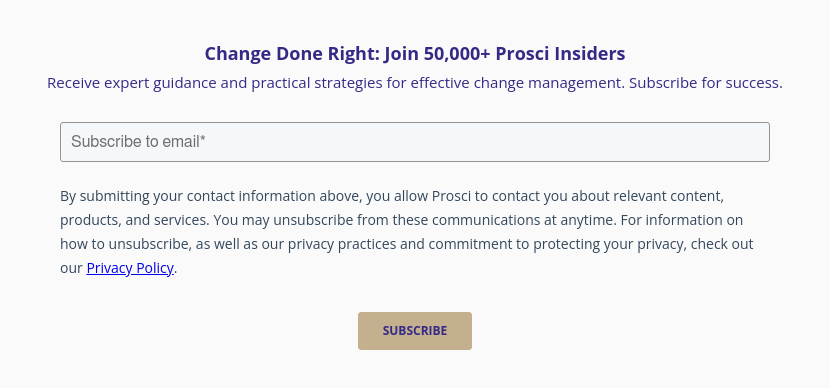Unlock Value With This IT Change Management Process Guide

7 Mins
Updated: August 19, 2025
Published: July 9, 2024

Over the coming years, the AI market is predicted to grow from $45 billion to $207 billion. Companies that successfully integrate AI and other cutting-edge IT systems will benefit immensely from the investments. And effective change management makes the most of those investments.
IT investment is the strategic lever companies use to unlock a new level of business outcomes, whether it's enhancing customer experiences, streamlining operations, or creating innovative products and services.
But implementing a large-scale IT system or even a full digital transformation is only half the story.
The reason companies struggle with large-scale changes like digital transformation is that they neglect the human side. According to our Best Practices in Change Management research, the biggest barriers to a successful IT change management process are:
- Resistance to change
- Lack of leadership buy-in and commitment
- Misaligned company culture
Let's look at how leaders can overcome the people-side business challenges of large IT investments and unlock the strategic and financial benefits of organizational change management.
But first, here's a quick refresher on the world of change management in the IT sector.
IT Change Management vs. Organizational Change Management
The term "change management" has a different meaning in the IT sector than in other industries. For decades, IT change management was defined and redefined alongside best practices in IT Service Management (ITSM) and iterations of the IT Infrastructure Library (ITIL).
- ITSM – The set of activities, policies and implementation processes that an entire organization uses to manage and deliver IT services to their customers.
- ITIL – A comprehensive set of best practices designed to help organizations manage and optimize their IT services.
ITSM and ITIL began as process-heavy approaches for designing, delivering and supporting IT services. While they included steps for people-side processes—like change enablement and change management—these components were spread throughout the library without a unifying concept.
But even with ITIL or ITSM, there was still a low success rate for organizational change in the tech space. In 2017, the Service Desk Institute found that only 12% of self-service IT initiatives realized ROI and intended benefits. For companies that significantly missed ROI, the main culprit was a lack of organizational change management.
Now in its 4th iteration, organizational change management takes a much larger role in the strategic recommendations of the ITIL.
Understanding the distinction between IT change management and organizational change management (OCM) is crucial for relevant stakeholders and decision-makers. This differentiation lies at the heart of how an organization implements and manages technological changes.
Differentiating IT Change Management From Change Management in IT

IT change management is characterized by its structured framework and the best practices from ITSM and ITIL. This process is crucial for managing the IT infrastructure, focusing on the technical aspects of change like software updates, network changes and hardware upgrades.
On the other side of the spectrum lies organizational change management (OCM). This approach is people-centric, focusing on the human side of change and developing strategies that:
- Facilitate and streamline change
- Mitigate risk and resistance to the change
- Support people to help them adopt and use changes to their work
The ITIL defines organizational change management as:
“The practice of ensuring that changes in an organization are smoothly and successfully implemented and that lasting benefits are achieved by managing the human aspects of change.”
The OCM approach recognizes that technology is only as effective as the people using it, emphasizing the importance of aligning human capabilities with new technological advances.
Essentially, IT change management is structured and technology-focused, while organizational change management is more flexible and people-focused. Both are integral to a comprehensive management strategy for effective change implementation in modern businesses.
With that understanding in mind, let’s turn back to the key reason behind increasing investment in the IT space.
The Big Why Behind Your IT Investment—Unlocking Strategic Advantage
According to Statista, worldwide spending on IT jumped from $4.3 trillion to just under $5 trillion from 2021 to 2024.
Companies across all industries are investing in digital transformation to increase the reach and impact of their products and services. The same is true for companies in the IT sector.
Uninterrupted production environments and faster service delivery are important, but the Big Why behind technical change management is really to unlock new opportunities for growth and competitive advantage. Product and service offerings based on the latest technology are strategic levers that Microsoft, Google, Amazon, and other tech companies use to win in a crowded market.
Here are a few examples of disruptive technologies prompting major investment over the past few decades and the Big Why behind each:
- AI – Exponentially increases the efficiency of human-computer interactions
- Blockchain – Creates secure, inalterable ledgers for democratized information storage
- Cloud computing – Allows companies to flexibly scale production environments and service delivery at a lower cost
- Mobile applications – Drastically expand consumer access to IT products and services
But these technologies all have another thing in common—the return on investment comes down to how effectively they are used by people. IT investment is as much about building up new skills and protocols among stakeholders as it is about integrating a new system.
The secret to unlocking ROI is matching the “hard” approach of ITIL change management with the “soft” approach of OCM.


A Paradigm Shift in Tech—Adopting a Holistic IT Change Management Process
You cannot overstate the significance of applying organizational change management processes during large technological transitions.
Yes, software and technology form the backbone of modern-day operations for all organizations, particularly in the IT sector. But they’re just one part of the system. The people using these tools and the processes governing them determine how successful an agile tech company could be.
One of our instructors with significant experience in technical change management perfectly encapsulates the importance of a holistic approach to technological change, stating:
"Change management isn't just a process; it's the foundation upon which service quality and customer satisfaction rest. It empowers organizations to navigate the digital landscape with confidence, ensuring they’re agile, resilient, and prepared for the future."
—Mavourneen Mainelli, Prosci Executive Instructor
Using a people-side change management methodology alongside the best practices of ITIL helps unlock a number of advantages for companies in the IT space, including:
- Improved Service Quality – OCM helps eliminate resistance to change to ensure continued high-service quality, significantly reducing service outages and lessening their potential impact on business continuity.
- Enhanced Customer Satisfaction – Organizations that quickly embrace change can focus on delivering reliable and consistent services, and customer satisfaction naturally follows.
- Increased Agility – Building change capabilities across technical and non-technical departments helps companies quickly adopt and use emerging technology and market developments.
- Reducing Costs and Risks – Drawn-out or unsuccessful digital transformations incur large financial and opportunity costs, meaning companies can realize considerable savings when change management is successful.
Even IT experts themselves have realized how important organizational change management is to achieving the common goals of ITIL. The best practice framework of ITIL highlights four key ways that OCM enables smooth and successful technological change:
- Clear and Relevant Objectives – Clearly communicate the Big Why of the IT investment so it makes sense to stakeholders and increases the likelihood of buy-in and long-term adoption.
- Strong and Committed Leadership – Build active support for the new technology among managers, day-to-day leaders, and other organizational sponsors to reaffirm top-down commitment to usage.
- Willing and Prepared Participants – Prepare participants for the new technology by providing relevant training, regular communications, and an opportunity to voice concerns.
- Sustained Improvement – Reinforce the use of the new technology on a regular basis with data and communication so people don’t revert to old systems or ways of working over time.
Certified Change Management Practitioners will notice something interesting about these benefits highlighted by the ITIL: they overlap almost entirely with the Prosci ADKAR® Model. This isn’t surprising considering how well this model for personal change aligns with sequential, iterative, and hybrid solution development approaches.
Iterative IT Change Management Process

Many Prosci Executive Instructors and Prosci Change Advisors come from backgrounds in the tech space. They know firsthand how applying the Prosci ADKAR Model and Prosci Methodology can significantly increase the efficiency of digital transformation and lay the groundwork for more effective change in the future.
Orchestrating ITIL Change Management at the Highest Level With the Prosci Methodology
For 30 years, Prosci has helped enterprise organizations in IT and beyond by focusing on the human side of change; doing so ensures that employees aren’t just informed but engaged, empowered and equipped to navigate the new landscape in alignment with the best practices of ITIL change management.
The strategic importance of organizational change management for IT companies lies in its capacity to facilitate successful adoption with minimal service disruptions. One key measure of successful digital transformation is how well it’s embraced by users and how effectively it achieves the desired business outcomes.
Prosci has worked closely with Microsoft over the past decade to help the company build up its internal change management department. Not only do the tech giants do Agile, but they are agile. Increasing its focus on the people side of change has helped Microsoft immensely, as you can see in the examples below.
Helping Microsoft Investor Relations exceed expectations during digital transformation
The Microsoft Investor Relations (IR) team is tasked with maintaining seamless communications between executives, investors and the larger financial community. One of their top priorities is delivering the company’s quarterly earnings reports to millions of people while safeguarding confidential financial data.
The IR engineering team was recently tasked with replacing the legacy publishing platform with a new Azure-based one that would reduce security threats. It was a high-stakes project involving complex IT changes and significant personnel and process changes within the IR team.
Recognizing the essential role of OCM in this initiative, Microsoft applied the Prosci Methodology extensively throughout this solution, including:
- Securing the necessary sponsorship from Microsoft’s Senior leadership team
- Coaching managers with the IR team to define roles and assign responsibilities
- Providing role-based training to fill skill gaps and rehearse for possible scenarios
- Managing resistance and addressing concerns within the senior leadership group
- Enabling consistent communication with technical networks to ensure all action items were completed
Thanks to the engagement, Microsoft IR was able to deliver the critical earnings report to its millions of consumers through the new Azure-based platform.
Check out the full Prosci and Microsoft success story here.

Increasing customer adoption rates with the Microsoft Enterprise Service team
Prosci has worked closely with the Microsoft Enterprise Services (MES) team in recent years. This project-based consulting arm helps Microsoft enterprise customers adopt platforms more quickly and use them to greater effect.
Unfortunately, the emergence of cloud technology and shifting market dynamics created new expectations among this customer base that the MES team needed to navigate. Change management became a central focus for driving revenue.
The MES team needed help building the credibility of its Adoption and Change Management services with a proven methodology. Prosci stepped in with the following solutions:
- Providing an enterprise license to help the MES team customize and scale the Prosci Methodology
- Certifying over 2,250 employees as change practitioners to build a foundation of change management competency.
- Making key change management resources available to over 250,000 Microsoft employees across the globe
- Customizing training for the consulting services as well as for self-service use by both partners and customers of Microsoft
Within four years of the engagement with Prosci, the Microsoft Enterprise Services team had already seen a return on its investment. MES-led change management workshops helped increase adoption rates by 450% for attending customers.
Read how Microsoft increased customer adoption rates with Prosci.
Jean-Claude Monney, the former Chief Knowledge Officer of Microsoft Services, has witnessed the rise of OCM as a strategic imperative in an IT industry that traditionally prioritizes the hard side of change. He cut his teeth navigating the IT change management process at the enterprise scale:
- Driving STMicroelectronics e-Business transformation in 2000
- Creating a joint venture between Intel and ST involving thousands of people
- Building a cloud-based knowledge platform for the Microsoft Services Office
But it was his experience learning about the Prosci ADKAR Model that sparked his “aha” moment around OCM in tech. It’s when he had a critical realization that should resonate with any CTO or tech leader: change management is its own program, not just a line item.
Gain a Strategic Edge With Organizational Change Management
Operational excellence is no longer the sole benchmark for IT organizations—the new frontier is achieving a strategic edge through an effective change management process.
As companies continue to integrate technology like AI, leaders also need to stop viewing change management from a purely technical perspective. Resistance to change and low rates of sponsorship from leaders are far more impactful on results than the efficiency of the IT change management process itself.
Embedding organizational change management principles into the fabric of large-scale IT projects is even recognized by the ITIL. Tech giants like Microsoft know that organizational change management transcends traditional operational benefits, such as cost savings and increased efficiency. Remember: it’s more than just a line item.



